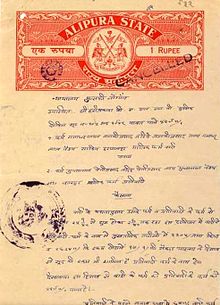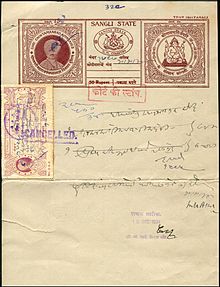Stamped paper



Stamped paper is an often-foolscap piece of paper which bears a pre-printed revenue stamp.[1][2] Stamped papers are not a form of postal stationery.
The use of stamped paper in the American colonies was so unpopular that it has been credited with sowing the seeds of the American Revolution.
Uses[]
Stamped paper has been widely used around the world to collect taxes on documents requiring stamping, such as leases, agreements, receipts, court documents and many others. The papers are bought blank apart from the pre-printed stamp and are available from stationers, lawyers' offices, post offices and courts according to local regulations. The parties to the matter then write their legal business on the paper and lodge it with the court or other interested party. This is an efficient way of collecting taxes and stamping documents without the need to submit them to a separate government stamp office.
History[]
Stamped paper is thought to have been a Spanish invention,[3] being introduced (or reinvented) in the Netherlands in the 1620s.[4] It has been used widely in France (from 1651),[4] Great Britain (from 1694),[4] the United States, India and elsewhere.
The 1765 Stamp Act required all British colonies in the New World to use stamped paper prepared in London and embossed with a revenue stamp.[5] This led to riots and political agitation which have been credited with sowing the seeds of the American Revolution.
Collecting[]
Collecting stamped paper is part of revenue philately.
Security measures[]
The stamp sometimes occupies the entire width of the top part of the paper and is often of an intricate engraved design in order to enhance security. The paper will also frequently have a whole page watermark for the same reason.[citation needed]
Current uses[]
Stamped papers remain in use in many countries; however, electronic versions are being developed in order to reduce the risk of fraud. This has particularly been the case in India following a recent[when?] large-scale fraud.[6] The use of stamped paper remains an important source of revenue in some developing countries, like Bangladesh, where other forms of taxation are hard to collect.[7]
See also[]
- Abdul Karim Telgi, an Indian stamped paper counterfeiter
References[]
- ^ Mackay, James. Philatelic Terms Illustrated. 4th edition. London: Stanley Gibbons, 2003, p. 147. ISBN 0-85259-557-3
- ^ "The British Postal Museum and Archive: Philatelic glossary". Archived from the original on 26 June 2013. Retrieved 26 February 2010.
- ^ de Lacroze, Jean Cornand (1802). A historical grammar: or A chronological abridgement of universal history. D. Carlisle for C. Bingham, p. 196
- ^ Jump up to: a b c Dagnall, H. (1994) Creating a Good Impression: three hundred years of The Stamp Office and stamp duties. London: HMSO, p. 3. ISBN 0116414189
- ^ "The Stamp Act of 1765 - A Serendipitous Find" by Hermann Ivester in The Revenue Journal, The Revenue Society, Vol.XX, No.3, December 2009, pp. 87–89.
- ^ E-Stamping of properties – a sure way of avoiding corruption and bribery in Bengaluru (Archived) Retrieved 26 February 2010.
- ^ Bangladesh Govt to Amend Stamp Law to Boost Revenue Retrieved 12 December 2010. Archived here
Further reading[]
- Castenholz, Bill. Field Guide to Revenue Stamped Paper, Castenholz and Sons, Publishers, Pacific Palisades, California, United States.
- Einstein, Joseph; Thomas C. Kingsley and W. Richard DeKay. Handbook for United States Revenue Stamped Paper, American Revenue Association, Inc., United States.
- Koeppel, Adolph. The Stamps that Caused the American Revolution, the stamps of the 1765 British Stamp Act for America, American Revolution Bicentennial Commission, New York, 1976.
External links[]
| Wikimedia Commons has media related to Stamped papers. |
This article's use of external links may not follow Wikipedia's policies or guidelines. (March 2017) |
- Embossed revenue stamp paper
- Essays based on the Wyon head intended for stamped paper submitted after 1839 by Charles Whiting
- United States Two-Cent Revenue Stamped Paper - The Civil War Designs
- Philatelic terminology
- Revenue stamps
- Spanish inventions